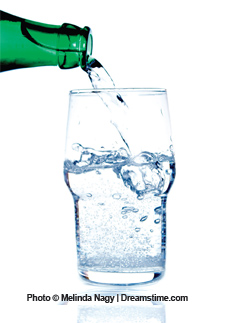 SCARCITY of potable drinking water supply in Egypt is helping to drive bottled water demand in the country. The Nile is the major drinking water source, but untreated wastewater released into Nile means the water is often below the minimum quality standards. Still bottled water sales were dynamic in 2009 due to tap water contamination and worries about related diseases, including stomach infection and kidney diseases, according to Euromonitor International. "The extremely hot summers in Egypt also drove demand. Moreover, continuous campaigns by Nestlé Egypt SAE highlighting the benefits of drinking plenty of water during the day drove sales. The campaign ran on both local and satellite television channels and achieved a high level of exposure across the MENA region," says the market analyst firm in its Bottled Water in Egypt report. Adding to the pressure on water resources is forecast population growth to 95 million in 2025 from about 75 million in 2008, leading to a decrease in per capita water availability from 800 to 600 m3per year, assuming that total water availability remains constant. Nevertheless, the Egyptian government has plans to increase sanitation coverage and wastewater treatment in rural areas in order to eliminate significant pathogenic pollution by the year 2017. Furthermore, the Integrated Sanitation and Sewerage Infrastructure Project of the National Organisation of Potable Water and Sanitary Drainage has as one of its objectives to improve water qualities in the Delta. Photo © Melinda Nagy | Dreamstime.comadidas
SCARCITY of potable drinking water supply in Egypt is helping to drive bottled water demand in the country. The Nile is the major drinking water source, but untreated wastewater released into Nile means the water is often below the minimum quality standards. Still bottled water sales were dynamic in 2009 due to tap water contamination and worries about related diseases, including stomach infection and kidney diseases, according to Euromonitor International. "The extremely hot summers in Egypt also drove demand. Moreover, continuous campaigns by Nestlé Egypt SAE highlighting the benefits of drinking plenty of water during the day drove sales. The campaign ran on both local and satellite television channels and achieved a high level of exposure across the MENA region," says the market analyst firm in its Bottled Water in Egypt report. Adding to the pressure on water resources is forecast population growth to 95 million in 2025 from about 75 million in 2008, leading to a decrease in per capita water availability from 800 to 600 m3per year, assuming that total water availability remains constant. Nevertheless, the Egyptian government has plans to increase sanitation coverage and wastewater treatment in rural areas in order to eliminate significant pathogenic pollution by the year 2017. Furthermore, the Integrated Sanitation and Sewerage Infrastructure Project of the National Organisation of Potable Water and Sanitary Drainage has as one of its objectives to improve water qualities in the Delta. Photo © Melinda Nagy | Dreamstime.comadidasDrinking water challenges plague Egypt
Source: Release Date:2011-01-06 171
 SCARCITY of potable drinking water supply in Egypt is helping to drive bottled water demand in the country. The Nile is the major drinking water source, but untreated wastewater released into Nile means the water is often below the minimum quality standards. Still bottled water sales were dynamic in 2009 due to tap water contamination and worries about related diseases, including stomach infection and kidney diseases, according to Euromonitor International. "The extremely hot summers in Egypt also drove demand. Moreover, continuous campaigns by Nestlé Egypt SAE highlighting the benefits of drinking plenty of water during the day drove sales. The campaign ran on both local and satellite television channels and achieved a high level of exposure across the MENA region," says the market analyst firm in its Bottled Water in Egypt report. Adding to the pressure on water resources is forecast population growth to 95 million in 2025 from about 75 million in 2008, leading to a decrease in per capita water availability from 800 to 600 m3per year, assuming that total water availability remains constant. Nevertheless, the Egyptian government has plans to increase sanitation coverage and wastewater treatment in rural areas in order to eliminate significant pathogenic pollution by the year 2017. Furthermore, the Integrated Sanitation and Sewerage Infrastructure Project of the National Organisation of Potable Water and Sanitary Drainage has as one of its objectives to improve water qualities in the Delta. Photo © Melinda Nagy | Dreamstime.comadidas
SCARCITY of potable drinking water supply in Egypt is helping to drive bottled water demand in the country. The Nile is the major drinking water source, but untreated wastewater released into Nile means the water is often below the minimum quality standards. Still bottled water sales were dynamic in 2009 due to tap water contamination and worries about related diseases, including stomach infection and kidney diseases, according to Euromonitor International. "The extremely hot summers in Egypt also drove demand. Moreover, continuous campaigns by Nestlé Egypt SAE highlighting the benefits of drinking plenty of water during the day drove sales. The campaign ran on both local and satellite television channels and achieved a high level of exposure across the MENA region," says the market analyst firm in its Bottled Water in Egypt report. Adding to the pressure on water resources is forecast population growth to 95 million in 2025 from about 75 million in 2008, leading to a decrease in per capita water availability from 800 to 600 m3per year, assuming that total water availability remains constant. Nevertheless, the Egyptian government has plans to increase sanitation coverage and wastewater treatment in rural areas in order to eliminate significant pathogenic pollution by the year 2017. Furthermore, the Integrated Sanitation and Sewerage Infrastructure Project of the National Organisation of Potable Water and Sanitary Drainage has as one of its objectives to improve water qualities in the Delta. Photo © Melinda Nagy | Dreamstime.comadidas
You May Like

 iConnectHub
iConnectHub
 Login/Register
Login/Register Supplier Login
Supplier Login


























